Musicarta Modes - Dorian Mode
The Dorian Mode
The Dorian mode occurs naturally on the white keys from D to D (“D for Dorian”)..
Download up-to-date MIDI files for this page

Like the Aeolian, the Dorian is a minor mode. The differences are:
- The Dorian IV chord is major (minor iv in Aeolian);
- The Dorian six chord of is a diminished triad and so is stripped out.

(As usual in the comparison tables, the diminished triad is stripped out.)
Dorian Riff – Modes Diary 24-06-14
The major subdominant chord creates a signature Dorian pair, i–IV, familiar from the blues and jazz-funk which the module riff showcases. Listen to it a few times to let the tonality ‘sink in’. The full MS is in your workbook.
Here’s the a signature Dorian i–IV. pair in all its inversions. The MS has the classical D minor key signature – Bë – so there are B naturals throughout (which tells you the music is modal).The second pass-through in the audio/MIDI clips has a pedal D bass with a little rhythm added.
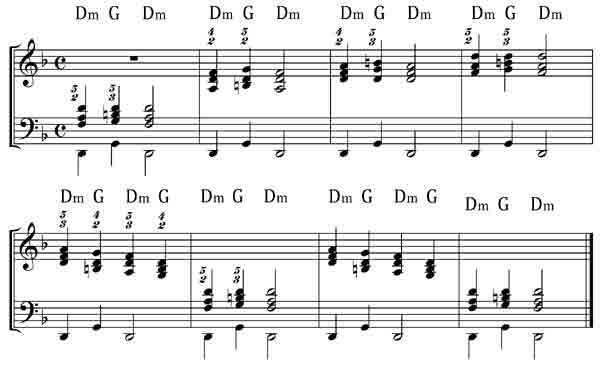
Without the major IV chord, that music would sound like the clip, below left. (This is also what the classical minor key would offer – use the same MS but ignore the B natural (ì) signs.). Compare with the major IV version (below right) to fully appreciate the modal tonality.
The riff itself uses plenty of reverse mediant substitution in the right hand – that is, third-up F chords, creating D minor 7 chords. Here is a the inversions drill incorporating Dmin7 chords.
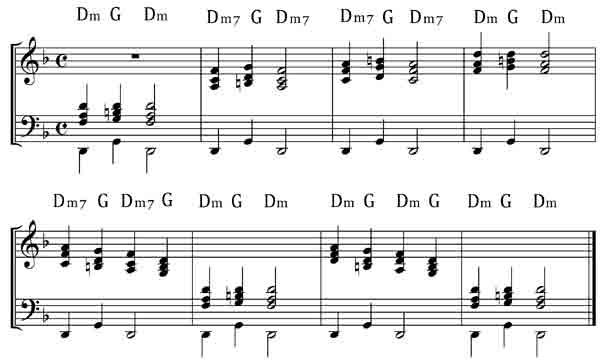
Here is a repeating audio/MIDI clip of just the first section of the module riff, which is built exclusively on D minor or minor 7 (i, i7) and G major (IV) chords. Use it as a play along track to practice your inversions.
Dorian harmony
Modes excel in providing strings of chords where the root falls a fourth. We have already come across the Mixolydian version – here in C.

The Dorian mode provides a four-chord cascade down to the home chord.
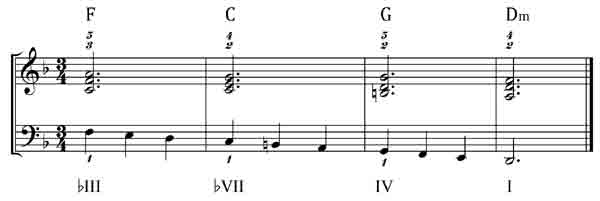
You hear the skeleton chords segue into the second part of the module riff.
These four chords sound particularly nice because the chords are:
major (ëIII – F), major (ëVII – C), major (IV – G), minor (i – D minor)
If you play the same sequence in the Aeolian mode, the minor subdominant will give you F–C–G minor–D minor – still useable, but much ‘darker’.
Use the MS above, ignoring the B naturals, to get the Aeolian version. In the second part of the audio, the right hand cycles through another set of F–C–Gm–Dm inversions with a bass line variation – see if you can ‘play it by ear’, or just copy the MIDI.
Syncopation in the module riff
Here is the riff chord sequence.

Notice the odd phrase length – the eleven-bar ‘Chorus’. Music usually comes in multiples of four bars, and slight variations on the pattern like this help make music interesting – although most listeners would not know what it was exactly about the piece that made it so.
The rocking-octave bass
The rocking-octave bass is quite hard work but worth it for any rock-styles keyboard player.
The first eight bars of the MS show a simplified practice-only version using just crotchets which doesn’t actually occur anywhere in the performance.

That's an acceptable 'stepping stone' performance. Your next step would be to practice quavers in the left hand, or perhaps a mix, as here. (This is what the left hand does in the ‘Chorus’ section.)

The next development would be the ‘flapping thumb’ (with the held little finger).

The thumb need not play every ‘flap’, nor the little finger always hold for a full bar.
In practice, once you have mastered a number of varieties, your left hand will (should) vary itself according to what the right hand is playing. Watch the module riff MIDI performance on MidiPiano to pick up particular patterns to practice. (It’s useful to study screen-shots to clarify what’s actually happening.)
The right hand
In the ‘Verse’, the melody actually plays inside the right hand chord.
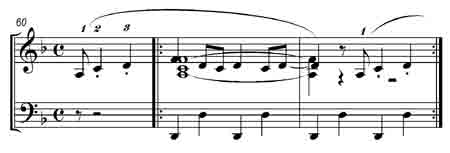
A screen-shot of this material in MidiPiano Piano Roll view makes it clear what you’re asking your fingers to do.
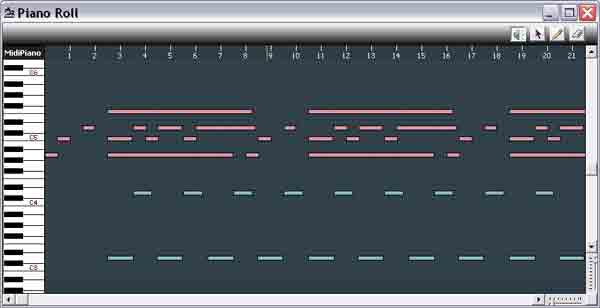
In the Chorus section, the right hand has its own version of thumb-side ‘flapping’. Here is an exercise for the essentials of the technique.

The audio plays right hand skeleton chords first time through. A simpler left hand would be quite acceptable to practice over. –
the ‘flapping thumb’ would be best. Remember that you can play your MIDI files as basic audio in most media players, and set to 'Repeat' for ionstsnt play-along practice tracks.
When you can play that, start introducing some syncopation in the top line – in particular, anticipation over the bar line.
Remember, your goal is to develop keyboard skills and get a ‘keep going’ performance out there, not to simply reproduce another performance. You build truly creative keyboard musicianship by building on ‘what you could do the time before’ – not on what you wish you could do, if only…!
The Musicarta Modes Workbook is also about knowing how the modes in particular can be used to put music together, and give you a starting point for your own compositions.
Finally, here is the module riff audio again for your convenience.
|
OUT NOW! |
THE MUSICARTA BEAT & RHYTHM WORKBOOK At last! An effective approach to keyboard rhythm & syncopation skills. Learn more! |
ONLY $24.95! |
MODES |
The MusicartaA methodical approach to keyboard syncopation for
|
PUBLICATIONS
exciting keyboard
creativity courses
CHORDS 101
WORKBOOK

~HANON~
video course

Musicarta
Patreon
PENTATONICS
WORKBOOK
video course

Creative Keyboard
video course

BEAT AND RHYTHM
WORKBOOK

- Volume 1 -

12-BAR PIANO
STYLES WORKBOOK

MUSICARTA MODES
WORKBOOK

PIANO STYLE

CANON PROJECT
video course

VARIATIONS
video course


- Piano Solo -
video course

- Piano Solo -


YouTube playlists





 THE LOGO
THE LOGO
